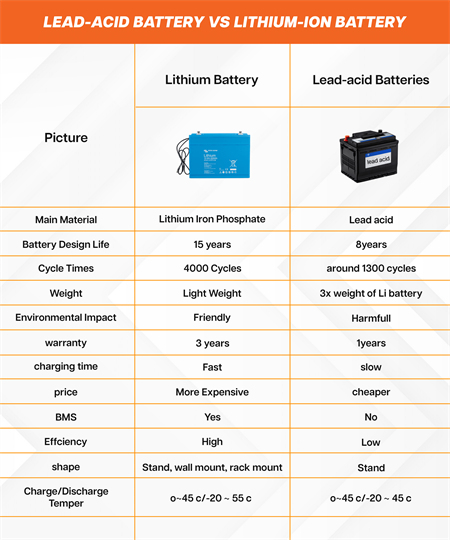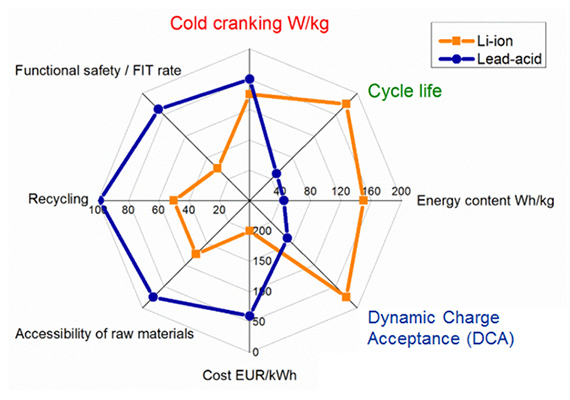リチウム電池を鉛蓄電池に交換できますか?
May 28, 2025鉛蓄電池は、鉛(Pb)と硫酸(H₂SO₄)の化学反応を電気化学反応とする充電式電池です。最も初期の充電式電池の一つです。リチウムイオン電池も充電式電池の一種で、正極と負極の間をリチウムイオン(Li⁺)が移動することで電気化学反応が起こります。現在最も広く使用されている電池の一つです。

場合によっては、リチウムイオン電池を鉛蓄電池に置き換えることができますが、以下の要素を考慮する必要があります。
1. デバイスの互換性
1.1 電圧マッチング:リチウムイオン電池と鉛蓄電池は公称電圧が異なります。例えば、一般的なリチウムイオン電池の電圧は3.7Vですが、鉛蓄電池は通常6Vまたは12Vです。デバイスがリチウムイオン電池を使用するように設計されている場合、それを鉛蓄電池に直接交換すると電圧の不一致が生じ、デバイスのパフォーマンスに影響を与える可能性があります。
1.2 サイズと重量:鉛蓄電池は一般的にリチウムイオン電池よりも重く、かさばります。携帯機器や電気自動車など、重量とサイズに制限のある機器の場合、鉛蓄電池は適さない場合があります。
2. パフォーマンスの違い
2.1 エネルギー密度:リチウムイオン電池は鉛蓄電池よりもはるかに高いエネルギー密度を有しており、より少ない体積と重量でより多くのエネルギーを蓄えることができます。電気自動車やポータブル機器など、エネルギー密度に対する要求が高い機器の場合、鉛蓄電池では不十分な場合があります。
2.2 サイクル寿命: リチウムイオン電池のサイクル寿命は通常、鉛蓄電池よりもはるかに長くなります。
2.3 充電速度: リチウムイオン電池はより速く充電され、通常 2 ~ 5 時間で完全に充電されますが、鉛蓄電池の場合は 8 ~ 10 時間かかります。
 (図は自動車分野における鉛蓄電池とリチウムイオン電池の特性を示しています。どちらの電池もコールドクランキングでは同様の性能を示します。鉛蓄電池はW/kgでわずかに優れていますが、リチウムイオン電池はサイクル寿命が大幅に向上し、Wh/kgでより高い比エネルギーと優れた動的充電受容性を備えています。リチウムイオン電池の欠点は、kWhあたりのコストが高いこと、リサイクルが複雑であること、そして鉛蓄電池に比べて安全性が劣っていることです。)
(図は自動車分野における鉛蓄電池とリチウムイオン電池の特性を示しています。どちらの電池もコールドクランキングでは同様の性能を示します。鉛蓄電池はW/kgでわずかに優れていますが、リチウムイオン電池はサイクル寿命が大幅に向上し、Wh/kgでより高い比エネルギーと優れた動的充電受容性を備えています。リチウムイオン電池の欠点は、kWhあたりのコストが高いこと、リサイクルが複雑であること、そして鉛蓄電池に比べて安全性が劣っていることです。)
3. アプリケーションシナリオ
3.1 鉛蓄電池に適したシナリオ:
コストが主要な考慮事項であり、デバイスにそれほど高いバッテリー性能が求められない場合、鉛蓄電池は手頃な価格の選択肢となる可能性があります。重量とサイズがそれほど大きくないシナリオ(UPSバックアップ電源など)では、鉛蓄電池で需要を満たすことができます。
3.2 リチウムイオン電池のシナリオに適しています:
リチウムイオン電池は、高エネルギー密度、急速充電、長寿命が求められる用途(例:電気自動車、ポータブルデバイス、太陽光発電システム)に適しています。また、過酷な環境下においても、リチウムイオン電池は高温・低温環境の両方において鉛蓄電池よりも優れた性能を発揮します。
4. 安全性と環境への影響
4.1 安全性: リチウムイオン電池は一般に、より優れた安全機構 (電池管理システムなど) を備えていますが、鉛蓄電池には鉛と硫酸が含まれており、環境や人体への健康に有害となる可能性があります。
ACEY-BP24-300A500A バッテリー管理システム試験装置 リチウム電池保護基板の機能と各種性能指標を検出できます。特に量産工場の検査に適しています。コンデンサシミュレーションによる電池充放電の原理に基づいて開発されており、多機能を備えています。操作が簡単で、検出速度が速いなど、ご要望があればお気軽にお問い合わせください。
4.2 環境への配慮: 鉛蓄電池のリサイクルと廃棄には、重金属汚染を避けるために特別な注意が必要です。
5. コストと予算
5.1 初期コスト: 鉛蓄電池は通常、リチウムイオン電池よりも初期コストが低くなりますが、リチウムイオン電池の方が寿命が長く、長期的にはコスト効率が高くなる可能性があります。
5.2 メンテナンスコスト: 鉛蓄電池は定期的なメンテナンス(例: 水の補充、清掃)が必要ですが、リチウムイオン電池ではほとんどメンテナンスが必要ありません。
結論として、デバイスがバッテリーの重量、サイズ、エネルギー密度、サイクル寿命を必要としない場合、また予算が限られている場合は、リチウムイオンバッテリーを鉛蓄電池に置き換えることを検討してください。ただし、高性能、携帯性、長寿命が求められるアプリケーションでは、リチウムイオンバッテリーの方が優れた選択肢となる場合が多いです。